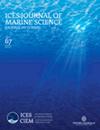监测近海风能与渔业资源相互作用的生态指标
IF 3.4
2区 农林科学
Q1 FISHERIES
引用次数: 0
摘要
海上风力开发(OWD)将产生急需的可再生能源,但也会给海洋生态系统带来一些压力。因此,有必要制定信息丰富的监测计划,以评估生态影响并提供减轻不利影响的解决方案。本文评估了 OWD 对渔业资源影响的潜在指标,包括总生物量指数、敏感物种、鱼类大小和营养动态,这些指标可作为监测计划的考虑因素。在美国新英格兰南部风能区(WEA)和新英格兰南部地区范围内,探讨了短期(年与年之间)变化以及长期趋势的方向和强度。大多数候选 OWD 指标在 WEA 规模、区域规模或两者规模上都表现出很大的时间变异性,这突出了在设计和持续监测计划时解决时间变异性问题的重要性。为在美国和其他迫切需要信息化监测方法的地方推进信息化监测方法提出了建议。其中包括建议至少收集 3-5 年的基线数据,并在风电项目的整个生命周期内持续监测。这将有助于了解所测量的生态指标时间序列的固有时间结构,从而将 OWD 影响与其他生态系统压力造成的影响区分开来。本文章由计算机程序翻译,如有差异,请以英文原文为准。
Ecological indicators to monitor offshore wind interactions with fisheries resources
Offshore wind development (OWD) will generate much needed renewable energy, but it will also introduce several stressors to the marine ecosystem. Therefore, there is a need to develop information-rich monitoring programs to assess ecological impacts and inform solutions to mitigate adverse effects. This paper evaluates potential indicators of OWD impacts on fisheries resources that could be considered for monitoring programs, including indices of aggregate biomass, sensitive species, fish size, and trophic dynamics. Short-term (year-to-year) variability and the direction and strength of long-term trends were explored at both the scale of the US Southern New England wind energy area (WEA) and at the scale of the Southern New England region. The majority of candidate OWD indicators exhibited substantial temporal variability at either the WEA scale, the region scale, or both, highlighting the importance of addressing temporal variability in the design and duration of monitoring programs. Recommendations are provided to advance informative monitoring approaches both in the USA and elsewhere where such approaches are urgently needed. Among these is a recommendation for a minimum of 3–5 years of baseline data collection and continued monitoring for the lifetime of the wind project. This will enable an understanding of the temporal structure inherent to the time series of ecological indicators measured so that OWD impacts can be disentangled from those caused by other ecosystem pressures.
求助全文
通过发布文献求助,成功后即可免费获取论文全文。
去求助
来源期刊

ICES Journal of Marine Science
农林科学-海洋学
CiteScore
6.60
自引率
12.10%
发文量
207
审稿时长
6-16 weeks
期刊介绍:
The ICES Journal of Marine Science publishes original articles, opinion essays (“Food for Thought”), visions for the future (“Quo Vadimus”), and critical reviews that contribute to our scientific understanding of marine systems and the impact of human activities on them. The Journal also serves as a foundation for scientific advice across the broad spectrum of management and conservation issues related to the marine environment. Oceanography (e.g. productivity-determining processes), marine habitats, living resources, and related topics constitute the key elements of papers considered for publication. This includes economic, social, and public administration studies to the extent that they are directly related to management of the seas and are of general interest to marine scientists. Integrated studies that bridge gaps between traditional disciplines are particularly welcome.
 求助内容:
求助内容: 应助结果提醒方式:
应助结果提醒方式:


